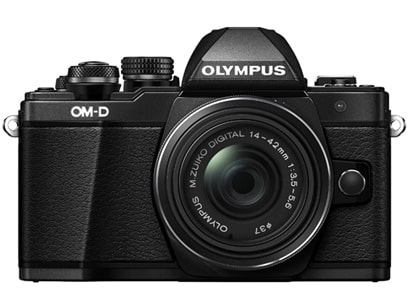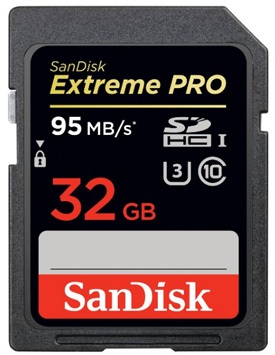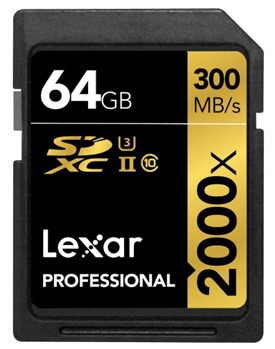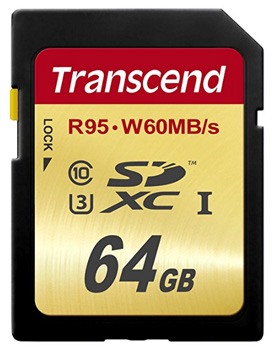Let’s take a look at the best memory cards for Olympus E-M10 II.
The E-M10 II has 1 x SD memory card slot that supports UHS-I speed. Don’t worry if you don’t know what this is, we’ll get to it in a second.
The Olympus E-M10 II is luckily not a resource intensive camera, which means most memory cards on the market today will be perfect.
Speed Class of SD Cards
| Class | Speed | Our opinion |
| Class 4 | 4MB/s | Too slow for most modern cameras. Skip it. |
| Class 6 | 6MB/s | A little bit better but unless you take 3 pictures a year, skip it. |
| Class 10 | 10MB/s | Good enough for most cameras with 20+ megapixels and Full HD video. |
| U1 (UHS) | 10MB/s | Good enough for most cameras with 20+ megapixels and Full HD video |
| U3 (UHS) | 30MB/s | Perfect for fast burst cameras, Full HD at 60fps and 4K video |
As we mentioned above, the E-M10 II supports UHS-I cards. This means you don’t have to spend more money on getting a UHS-II (faster), because the interface of the camera will automatically convert those cards as if they were UHS-I.
Where would UHS-II make a difference in this case? Only when sending the files to your computer or previewing them on the camera; these two processes would be much quicker, but you also need a USB 3.0 memory card reader.
Because the E-M10 II has Full HD at 60fps and 8fps burst mode, any UHS-I card will almost be fine. However, we don’t recommend picking a Class 4 or 6 card, as these might even result in in-camera errors since they’re not good enough.
Go with a 32GB or 64GB sized card (from $10 to $25), and buy a couple of these if you need lots of storage. It’s better than buying one huge card because you risk losing all of your shots if that 1 card fails.
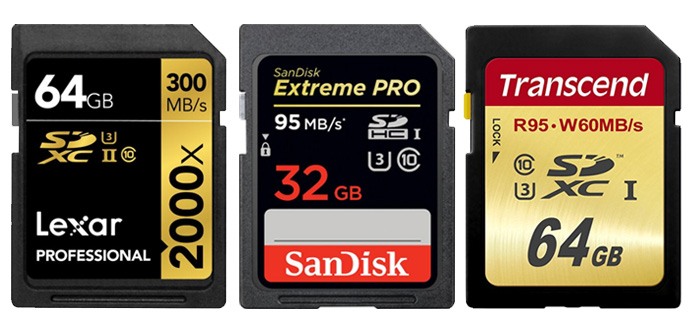
These are the best 3 SDHC/SDXC memory cards you can get:
- SanDisk Extreme Pro 95MB/s UHS-I U3
- Lexar Professional 300MB/s UHS-II U3
- Transcend R95/W60MB/s UHS-I U3
SanDisk Extreme Pro 95MB/s UHS-I U3
The SanDisk 64GB Extreme Pro 32GB U3 is our favorite card, seeing as it’s inexpensive and provides writing and reading speeds near 90MB/s.
The speed makes it perfect for whatever you’re doing; fast bursts with large megapixel cameras, 4K video, let alone Full HD at 60fps. It comes in 16GB, 32GB, 64GB, 128GB and 256GB sizes. It’s a perfect match for the Olympus E-M10 II and is in fact an overkill. An affordable overkill to be precise, so get this card if you’re looking for the best deal.
You can buy it at Amazon or see more reviews here.
Lexar Professional 300MB/s UHS-II U3
The Lexar Professional 300MB/s UHS-II U3 offers faster speeds for both writing and reading files. The Olympus E-M10 II doesn’t support UHS-II so the only benefit you’ll get is from sending the files on your computer. If that matters to you and you often send hundreds of images and dislike the waiting time, then consider getting this one as you will see a huge improvement compared to the UHS-I speeds. Also, when you decide to upgrade to a newer camera, chances are it will already have a UHS-II interface.
Don’t have a memory card reader that supports such speeds? Luckily you get a free Lexar UHS-II reader that’ll greatly reduce the waiting time. You also get a free downloadable Imaging Rescue software. It comes in 32GB, 64GB and 128GB sizes.
You can buy it at Amazon or see more reviews here.
Transcend R95/W60MB/s UHS-I U3
The most affordable on our list, yet still UHS-I, is the Transcend 64GB UHS-I U3. In terms of reading speed it goes up to 95MB/s, while for writing the maximum is 60MB/s.
Transcend, just like Lexar above, gives you the option of downloading their free image recovery program and they both work pretty good in most cases. It comes in 64GB, 128GB and 256GB sizes.
You can buy it at Amazon or see more reviews here.
Comparison of the 3 Memory Cards
| Card | Size | Speed |
| Sandisk Extreme Pro 95MB/s U3 | 32GB | Writing files: ~90MBs. Reading files: ~95MB/s |
| Lexar Professional 300MB/s U3 | 64GB | Writing files: ~240MB/s. Reading files: ~280MB/s |
| Transcend R95/W60MB/s U3 | 64GB | Writing files: ~60MB/s. Reading files: ~90MB/s |
What Brands are the Best?
Your photographs and videos are stored on a memory card, so you should definitely not try to save any money here by buying from unknown, cheap brands. While you save a few bucks, you probably won’t even get the advertised speeds, and are at a bigger risk of losing your shots.
We see too many beginners choosing the cheap route here, but until you transfer your shots to a computer/online, this is where they’re stored at. You want the memory card to be the most reliable piece of your equipment!
Stick to Sandisk, Lexar, Transcend, Kingston, Sony and Toshiba. There may be a few other good brands out there, but the ones we mentioned are already more than enough and offer great prices.
https://www.youtube.com/watch?v=HZSf2bKp9P0
Last Updated on September 14, 2021 by Nick Voorhees
First and foremost, I’m a husband and father. Then professionally I’m photographer, designer, blogger, and Esty store owner. My homebase is near the stunning Wasatch mountains in Utah but I love traveling with my family as part of our homeschooling journey. I also love teaching and helping out others. My faith is one of the biggest aspects of my life and brings be a consistent joy that I haven’t found in anything else. My main blog is BestPhotographyGear.com and I strive to make photography simple for anyone looking to learn or find gear for their individual needs. By nature, I like to study, research, and analyze things and I use that help provide the best advice and reviews I can.

